by Naomi L. | July 24, 2013 | Blog, Creative Writing, Featured, Tropes |
I’m polymerized tree sap and you’re an inorganic adhesive, so whatever verbal projectile you launch in my direction is reflected off of me, returns on its original trajectory, and adheres to you.
– Dr. Sheldon Cooper, The Big Bang Theory (Season 1, Episode 13 – The Bat Jar Conjecture)
Fans of the comedy TV series The Big Bang Theory likely remember this quote from the Physics Bowl episode, when Sheldon reacts to an insult from fellow physicist Leslie Winkle by saying as condescendingly as possible that “he is rubber and she is glue”. However, the fact that he seems to go out of his way to use the most advanced vocabulary possible in his retort only adds to the hilarious running gag of Leslie always managing to beat her rival at a game of wits.
So what lesson should novice writers be learning from Sheldon’s backfired comment? That trying too hard to sound smart often has the opposite effect than what you might expect, that is, it hurts more than it helps.
What is this amethystine composition of which you speak?
Writing that is overly decorated with fancy words and elaborate details is known as “purple prose”. It’s an especially common practice among inexperienced writers, who often believe that to write a really good story (or improve upon an existing dull one), one needs to dress up the prose with as many big words as possible to make their work look sophisticated. Basically, beginners seem to have this grand illusion that great literature is that which stands above the level of everyday speech.

Purple prose: Contemplate this exquisite aubergine blossom of the Rosaceae family
Everyday speech: Look at this beautiful purple rose
But here’s the problem with that logic: everyday speech is the level where most readers are, and more importantly, where they want to stay. Readers today don’t want to bore their way through long descriptions or have to pause at every other page to look up half the words they just read in the dictionary. They want writing that’s simple, that they can understand and find relatable, similar to the language they use themselves in the real world.
So I’ve been writing erroneously… I mean, wrong all this time?
Calm down, and take a second to note that I said “similar to”, not “the same as”. It’s OK to use some higher-level vocabulary and detailed narration in your stories, for when done in moderation and in tone with the style of the work, these can actually add to the quality of your writing. The danger is using these tools in excess, because after you’ve passed a certain point in flowering up your prose, these details will begin to draw attention to themselves and away from the flow of your story. To sum up, a little is fine, but too much is bad. Write with caution.
Now before anyone accuses me of hypocrisy, allow me the chance to admit to this embarrassing fact: I am guilty of writing purple prose. Even if I don’t always choose the fanciest synonyms I can find to replace everyday words, I love decorating my writing with adjectives and adverbs, and I tend to use intermediate-level words where common ones would work just fine. That being said, I used to be much worse. When I first started writing, I had this idea that nobody would want to read stories written in the plain language of a ten-year-old, so even though I was already well-read for my age, I went out of my way to find “bigger and better” words for my fiction. It wasn’t until I started learning about common writing mistakes as a young adult that I realized how flowery my early writing was, and I’ve since been gradually cutting the bad habits of my childhood. So take it from a writer who’s still breaking out of the novice phase: tone down the purple and focus on writing simple prose. Your readers will appreciate it.
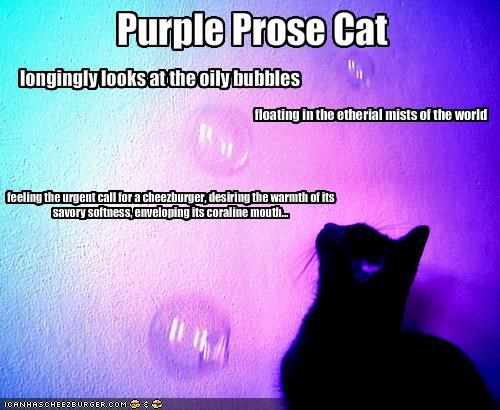 It’s worth noting at this point that as strongly as most experienced writers will argue against this practice, prose style is and always will be subjective. It’s entirely possible for a writer to not only be aware they write such elaborate prose, but actually do it on purpose. So if you’re a beginning writer guilty of this trope, don’t feel bad right off the bat. Maybe your goal is to imitate the exact styles of writers like William Shakespeare, Charles Dickens and Jane Austen, and that’s fine. Just know that unless you’re going for satire, most of the audience who would take your work seriously has probably been dead for a few hundred years.
It’s worth noting at this point that as strongly as most experienced writers will argue against this practice, prose style is and always will be subjective. It’s entirely possible for a writer to not only be aware they write such elaborate prose, but actually do it on purpose. So if you’re a beginning writer guilty of this trope, don’t feel bad right off the bat. Maybe your goal is to imitate the exact styles of writers like William Shakespeare, Charles Dickens and Jane Austen, and that’s fine. Just know that unless you’re going for satire, most of the audience who would take your work seriously has probably been dead for a few hundred years.
But I want to be taken seriously today! What should I do?
Don’t worry, the “purple prose bug” is treatable! For those of you aspiring writers who wish to establish yourselves before you try to follow the great authors who bend the rules, here’s a quick list of common purple prose mistakes and how you can avoid them:
1) Excessive detail. Yes, describing the setting of a scene before the action starts is often essential to telling a good story, but please don’t go on for a dozen pages about the hundred different colors in the sky or the history hidden in every brick of every building. Just because authors like J.R.R. Tolkien and Victor Hugo could get away with it doesn’t mean you can. One paragraph should be enough to set your scene, but no more than two.
2) Overly decorated nouns and verbs. If you’re one of the millions of readers who have read all of J.K. Rowling’s Harry Potter books, you may have learned that nouns and verbs should almost always include a “modifying friend”. But Rowling is an exception, a world-famous author of one of the best-selling book series in history, which you are (probably) not. That means she can do whatever she wants with her writing, whereas you should practice creating basic prose before you work too hard to copy her style. Try not to use too many adjectives and adverbs in your writing. Though this may seem counterintuitive, many famous writers would agree that less is more. If you don’t believe so, read a story by Ernest Hemingway or Mark Twain, and you’ll see how writing can be great without the need for too many “attachments”. To quote Twain, “When you catch an adjective, kill it.”
3) Said bookisms. This is one of the most common mistakes made by beginning writers: the constant use of alternative verbs for the word “said”. There’s a general belief that when it comes to writing dialogue, “said” is too plain and overused, so writers should go out of their way to replace it with words like “asked”, “muttered”, “hissed”, etc. As a teenager, I used a lot of these in my writing; I wouldn’t be surprised if I read back a dialogue-heavy scene from one of my old stories and found at least three pages between consecutive uses of “said”. But even famous authors seem to be guilty of this sometimes (I’m given to understand there’s an entire blog devoted to poking fun at the purpleness of Stephenie Meyer’s Twilight series), so don’t feel too bad if you find your own writing full of these bookisms. The important thing is that you know you should fix them. Dialogue should convey tone by itself, no extra tags required.
4) Too much “fancy vocabulary”. Continuing from the example of “said”, some writers tend to try and find as many advanced-sounding synonyms as possible to substitute the common words in their stories. While this may be fine once in a while, you shouldn’t run to the thesaurus for every other word you want to write. Otherwise, you’ll end up sending your readers to the dictionary just as frequently. It’s great to learn new words, but think about it for a second: the more time you put into driving your audience to read another book, the less time they’ll spend reading yours. Try to stick to vocabulary that your readers will understand, and if you must throw in a higher-level word now and then, at least have the courtesy to make its definition clear in context.
5) Exaggerated sentiment. There isn’t a lot I can say here except that this is pretty much a writer’s attempt to manipulate the reader into reacting a certain way to their writing. Going back to the first item on the list, if you throw too much rhetorical writing into your stories, it comes across as you trying too hard to evoke specific emotions from your readers, which more often than not will have the opposite effect. Trust your audience to understand what you’re trying to tell them. If you write it plainly enough, they will feel it.
Purple prose is a dangerous habit of many writers, and while it may be OK for some, most should make a point of avoiding or overcoming it, no matter how difficult this seems. If nothing else, choosing to create simple and clean prose is a sign of respect to your work and your readers, so take care with your style of writing. I’m certainly still trying.
So what are your experiences with purple prose? Have you read stories that you found too flowery for your taste? Were you (or are you) ever guilty of making these mistakes yourself?
by Naomi L. | July 3, 2013 | Blog, Creative Writing, Tropes |
Confused about the title? Or maybe you’re confused about my asking if you’re confused about the title? Or maybe you’re confused about my asking if you’re confused about my asking if you’re confused about the title? Or maybe you’ve had enough if this nonsense and just want me to get to the point?
This week’s creative writing topic is an interesting trope of which I’ve become rather fond over the course of my own writing: a technique known as “lampshade hanging“, or simply “lampshading”. It’s an idea I first learned about when reading TV Tropes, and because of the way I often see it being employed in humorous writing, it’s quickly becoming one of my favorite devices in fiction. But you probably don’t care yet what I think about it; you’re just waiting for me to explain what it is so you can decide whether you’d like it too. Unless you went ahead and skipped to the next paragraph before reading this one and already realize how I’ve been incorporating the trope into this blog post. Am I right?
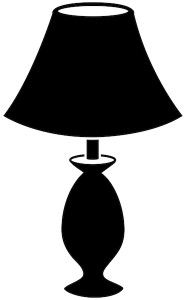
This is not the lamp you’re looking for…
OK, no more stalling. Lampshade hanging is a trick employed by writers to address any noticeable implausibility or obvious trope usage in a plot by drawing attention to it… and then moving on. But wait, why would you want to point out your story’s flaws in the first place? Counter-intuitive as it may seem, this exercise does have a few advantages:
- It proves you aren’t trying to get away with a questionable plot development by showing your audience that you’re also aware of the absurdity;
- It establishes a sense of realism in your story by demonstrating that your characters are just as skeptical about the implausibilities in the plot as the real-life people following it; and
- It’s a way to beat critics to the punch of deprecating you for the “mistakes” you already know are in your story.
Need an example? Here’s a rather brilliant one from my favorite moment in the 2000 Disney film An Extremely Goofy Movie, when Bobby Zimmeruski randomly realizes something strange about the world around him…
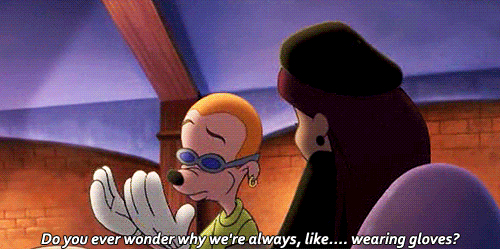
You know you’ve always wondered the same thing…
The best part? This question is almost immediately dismissed and never comes up again for the rest of the movie!
It should be noted that whenever a writer “hangs a lampshade” on a particularly glaring plot hole, it could be taken as a hint from their subconscious about the true extent of an unforgivable absurdity in an otherwise serious work. Of course, the technique can also be observed in use to the extreme in stories that are intended to be especially humorous and even self-aware, which (when done well) can be very entertaining (like in this product placement clip from the comedy TV series 30 Rock, which brilliantly demonstrates Tina Fey’s mastery of humor tropes). Mostly, though, it works just fine when used in moderation, kind of like a brief comic relief to complement the action in the rest of the story.
Bonus note: aside from “lampshades”, the practice is also known as hanging a “red flag”, “lantern”, or “clock”. The trope is referred to as “lampshade hanging” in my blog because it’s the most common term used on the TV Tropes website, which in turn attributes the phrase to Mutant Enemy.
While I don’t hang lampshades often in my fictional works, I do enjoy throwing them into my blog posts now and then, which I tend to use for humorous purposes as a personal reminder not to take myself or my writing too seriously (a flaw of which I’m painfully guilty, possibly evidenced by the fact that I don’t like to end phrases with prepositions). Hopefully my readers find them entertaining, or at the very least, tolerable. I do enjoy practicing lampshade hanging, and if you like to keep an element of comedy in your own writing, you might like to take it up too!
Now if you’ll excuse me, I must go do extensive research for the next blog topic on which my novice writer’s knowledge is still relatively limited. Thanks for reading!
by Naomi L. | May 15, 2013 | Blog, Creative Writing, Tropes |
Do you ever find yourself reading a book or watching a movie and noticing certain elements in the story that you’re sure you’ve seen before in the plots of other works of fiction? Or better still, do you ever find yourself talking about stories from these media and mentioning said elements in the form of a question that starts with, “You know that thing where…”?
Chances are there’s a trope for that.
What is a trope, you ask? Well, it’s not entirely easy to explain, as the definitions may vary slightly based on opinion. The simple definition is that tropes in fiction are devices that have become common enough throughout their respective media to have established themselves as conventions in the minds of the audience, and thus are reliable to writers as useful tools in creating fiction. A slightly more complex definition expands on this simpler one to also include examples of such conventions in real life, as in behind the scenes or even real-world events. Of course, a much more thorough explanation can be found on the website’s homepage itself, so instead of launching into a long and tedious description of TV Tropes and its endless supply of examples, I’ll simply provide a brief account of my own experience with the site and leave the option of following the link provided to your own discretion.

Follow the link in this logo at your own risk.
One of my first visits to this site was when I was looking up information about a certain Disney movie (I want to say it was Tangled, but my memory fails me). What I found was an abundance of tropes used throughout the film that could be easily recognized as conventions present in the plots of other stories (Character Development, Non-Human Sidekick, Happily Ever After, etc.). I was so intrigued by this new resource I had discovered that it wasn’t long before I started referring to it for examples of tropes in other fiction works – films, TV series, literature – learning more about these devices with each page I opened.
So why would I say this site will ruin your life? Because there’s a very good chance that at least once (and probably on your first visit), you’ll fall into the same trap I did: the web of tropes. On virtually every TV Tropes page, there will be a link that catches your eye, leading you to another page with more interesting information and new links, which in turn lead you to other pages with their own intriguing links… until the next thing you know, it’s an hour later and you can’t remember which page you originally meant to read without checking your browser tabs or history for a reminder. How did that happen?
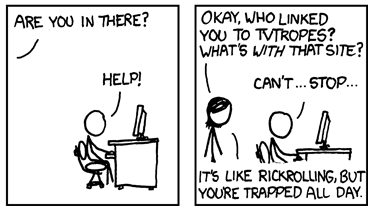
In case you need a visual aid, my experience with TV Tropes (and that of countless others) can be summed up in this webcomic. (Courtesy of xkcd)
Here’s an example of one of my typical TV Tropes sessions: I start by opening the page of a classic Disney film, let’s say Beauty and the Beast. One of the listed tropes is the famous True Love’s Kiss, complete with a brief explanation of how the instance in this particular movie is more of a variation than a straight example, which sparks my curiosity to read about other examples in different works. A moment later, I’m reading this trope’s description on its own page when… Wait, what in the world is a Dead Unicorn Trope? Obviously I go to that page to find out, only to realize in two seconds that I’ll first need to know what a Dead Horse Trope is in order to understand the unicorn variation, but this one interestingly turns out to be a common cause of a phenomenon known as Seinfeld is Unfunny… Several pot holes later, I’m back at the True Love’s Kiss page reading about how it’s a subcategory of a greater trope known as the Magic Kiss, leading me into another chain of links through the site. After another half hour, I go back to reading the list of tropes in Beauty and the Beast, where I soon find another trope that intrigues me, and the whole thing starts all over again.
But you know what? I love every minute of it, because even if I know TV Tropes will ruin my life on one hand, in a way, it also enhances my life on the other.
TV Tropes is an excellent resource for anyone who appreciates works of fiction, and especially for writers of such works. Learning about the various devices used in media and how they function in their respective plots teaches us how to analyze fiction critically, allowing us to develop a keener understanding of the elements that make up a story. This is particularly important for writers, because we more than anyone else should have as thorough a knowledge as possible in the workings of the stories we wish to create. How can we expect to write good fiction if we don’t have a decent understanding of the myriad of tools at our disposal?
So yes, by pulling you into its vortex of interesting content, TV Tropes may easily ruin your life. But in the end, if you somehow emerge with a refined outlook and even a new respect for the fiction you already love, then wouldn’t you really just be exchanging it for a better life?

 It’s worth noting at this point that as strongly as most experienced writers will argue against this practice, prose style is and always will be subjective. It’s entirely possible for a writer to not only be aware they write such elaborate prose, but actually do it on purpose. So if you’re a beginning writer guilty of this trope, don’t feel bad right off the bat. Maybe your goal is to imitate the exact styles of writers like William Shakespeare, Charles Dickens and Jane Austen, and that’s fine. Just know that unless you’re going for satire, most of the audience who would take your work seriously has probably been dead for a few hundred years.
It’s worth noting at this point that as strongly as most experienced writers will argue against this practice, prose style is and always will be subjective. It’s entirely possible for a writer to not only be aware they write such elaborate prose, but actually do it on purpose. So if you’re a beginning writer guilty of this trope, don’t feel bad right off the bat. Maybe your goal is to imitate the exact styles of writers like William Shakespeare, Charles Dickens and Jane Austen, and that’s fine. Just know that unless you’re going for satire, most of the audience who would take your work seriously has probably been dead for a few hundred years.




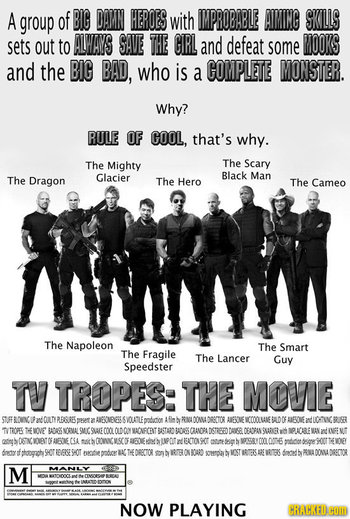

Recent Comments